Ireland, The Emerald Isle. Thousand shades of green, and weather that makes them possible. While Ireland may be wet most of the year, the glistening leaves sparkle after a rainshower and the humid climate promote this verdant countryside. US-based traveller Saul Schwartz roamed the roads of southwest Ireland before sent home due to the Corona virus travel ban. Here is the first of 3 accounts of his encounter with the Emerald Isle.
By Saul Schwartz
My wife Fern and I, joined by four relatives, planned our tour of Southwest Ireland months prior to our March 2020 trip. Unfortunately, the last two days of the trip were disrupted by the travel ban, but nevertheless we really enjoyed our time in the south of Ireland.
We flew into Shannon Airport to start our trip, on British Airlines through London and then on Aer Lingus into Shannon. We landed into Shannon’s small airport at 11:30 a.m. We quickly claimed our baggage and cleared customs. Then we were on a noon shuttle to Limerick, where we began our Tour of Southwest Ireland!
Limerick county
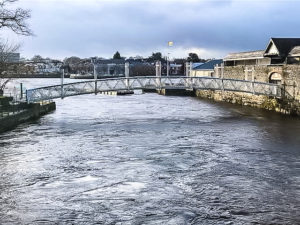
Limerick
Our first stop was in Limerick, located about 17 miles from the Shannon Airport. Limerick is located on the River Shannon, the longest river in Ireland, and is the third largest city in Ireland. We ate a very informal light lunch with our first Irish brown bread, a delicious whole wheat loaf made by Brennan’s.
We walked from our hotel to see the city’s attractions, starting with Saint Mary’s Cathedral.
The Cathedral church is located on Bridge Street just onto King’s Island. The Cathedral was founded in 1168 by King Donal Mor O’Brien on the site of his palace as the King of Munster. The church is named for Saint Mary the Virgin. The tour is self-guided.
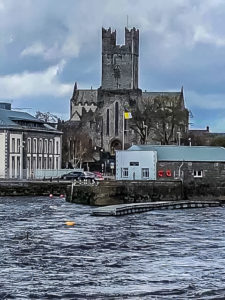
The Cathedral has a wealth of beautiful stained glass in its windows which highlight biblical stories in vivid colors and the church contains a pre-Reformation stone altar. The cathedral remains a place of worship today and is also used for recitals and concerts. It is the oldest building in Limerick still in daily use. As part of the Church of Ireland, there are daily services. The organ dates from 1624. There are six chapels within the Cathedral. Just outside the Cathedral, the graveyard dates from the 12th century. The 5 Euro entry fee is used toward the cost of maintenance of the church. Credit cards are not accepted for entry.
Next, we toured the imposing riverside King John’s Castle on King’s Island. This tour is also self-guided and a brochure is provided in the new Visitor’s Center. Inside the Visitor’s Center, there are exhibits explaining the history of the town.
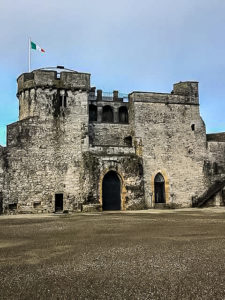
The medieval castle is about 800 years old. Building work began in 1212 and took decades to complete. The castle has distinctive rounded gate towers and thick curtain walls. Inside this great castle, the Normans planned military campaigns. During sieges in 1642, 1651 and 1690, many people were trapped within the castle walls and suffered truly dreadful conditions. At the end of the 20th century, the castle was reclaimed as a national monument. The cost of admission was 9.50 Euros per adult.
We very briefly stopped by the stone where the Treaty of Limerick was signed in 1691. King John’s Castle was surrendered under the treaty. This treaty was part of the larger European struggle between Protestant King William III and Catholic King James for the English crown.
We also walked by a bronze sculpture of dock workers designed by Limerick born artist Michael Duhan. The sculpture depicts two dockers carrying a piece of timber. The sculpture helps us remember that Limerick was one of Ireland’s busiest docks.
We walked over an interesting white footbridge by the potato market. The bridge crosses the Abbey River and was built in 1987. The bridge is dedicated to the memory of a local surgeon, Sylvester O’Halloran.
In Limerick, we stayed at the Clayton Hotel for two nights. From our room, we had an exceptional view of the River Shannon. Although the hotel had a fitness center, because it did not open until 7 a.m., we were unable to use it during our stay. This hotel is conveniently located on Steamboat Quay. On the first night we had an enjoyable three course dinner with wine/liquor and a choice of menu items at the hotel restaurant. Both Fern and I really enjoyed the fish entrée.
Clare County

Cliffs of Moher
On our second day we toured the Cliffs of Moher during a drenching rainstorm. There are about five miles of sheer cliffs rising as much as 760 feet above the ocean. On the limestone cliffs near the visitor center, we savored the breathtaking panorama of the Clare coast and the Atlantic Ocean. From the cliffs, we observed O’Brien’s Victorian viewing tower.
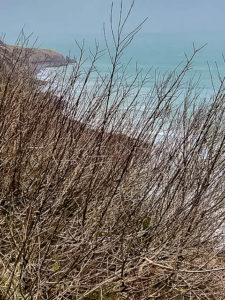
Because the weather was so bad, we spent some of our time at the Cliffs inside the Visitor Experience Center looking over the exhibits and viewing a little film showing a bird’s eye view of the Cliffs.
Wild Atlantic Way
Our bus then drove through the lush green countryside of the Shannon region. We drove along the West Coast of Ireland, along the spectacular Atlantic Coastline and into Galway County. This ride is called Ireland’s Wild Atlantic Way.
Galway County
We had a lunch stop in Galway, a buzzing seaside destination and the regional capital of County Galway. We made our way to the Spanish Arch then through Eyre Square by the old city walls and into John Kennedy Park. The historic Spanish Arch is a picturesque location on the sparkling River Corrib and was one of four arches built in 1594 and to remind us of Galway’s trade links to Spain.
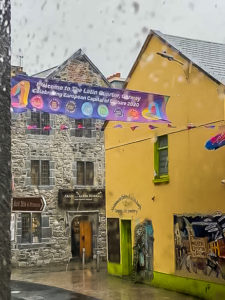
Eyre Square is also called John F. Kennedy Park in commemoration of his visit to Galway in 1963, shortly before his untimely death. The pedestrian park is the hub of Galway. We explored the famous cobblestone streets and meandered through the town’s winding alleys. Within the town on William Street, we wandered by a bronze sculpture of the two writers Wilde and Eduard Vilde, both sitting on a granite bench looking at each and conversing. We saw signs indicating that Galway has been awarded the European Capital of Culture designation for 2020.
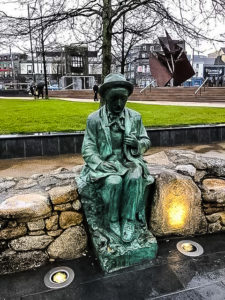
Within Eyre Square, there are the remains of a middle age doorway called the Browne doorway. The doorway was the former entrance to a house from 1627. It was removed from its original location in 1905.
The monument is a reminder of the great architecture in the days of Galway’s civic opulence between the 16th and 18th centuries. The Renaissance doorway displays fine carving details and includes the coats of arms of the two families united by marriage. Also, within the square, there is a bronze statue of Padraic O’Conaire, a local writer.
We had a nice lunch at the restaurant within Jury’s Inn on Quay Street. We enjoyed a salad and sandwich. The restaurant had a bar/pub atmosphere with a limited menu and reasonable prices.
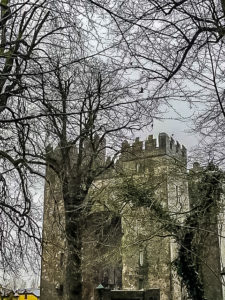
Bunratty Castle
That evening we had a four-course candlelit dinner as part of a mock Medieval Banquet at historic Bunratty Castle, along the O’Garney River. The five-story structure with its grey stone walls was restored in 1954.
The 15th century castle was one of the strongholds of the O’Brien family clan (Earls of Thomond) and it is one of Ireland’s premier visitor attractions. Entertainment consisted of stepping back into 15th century Ireland.
The festive evening began with a musical welcome and a goblet of honey mead. We were then wined, dined and entertained in the Banqueting Hall and Great Hall of the grand old castle. The butler and the costumed ladies of the castle in period dress helped make this a memorable evening. The lavish entertainment featured songs, the tones of the Irish harp and fiddle and more.
The cost was 79 euros per person. The dinner was multiple courses, but we did not find the food spectacular. The bread and soup were the highlight for us. Only a knife is provided to simulate the eating methods of that time period, using fingers primarily. Seated at long tables, the baronial hall was very crowded. To add to the fun, a lord and lady are chosen from participants to reign over the proceedings. Also, one participant was chosen to be thrown into the dungeon.
Touring tips
Weather
The Emerald Isle is very green due to the frequent rain. During our March trip, it rained every day, with occasional breaks in the clouds, but no sun. The temperatures ranged from around 35 to 50 degrees Fahrenheit. The weather was windy, rainy and quite cool during most of our trip. Layered clothing with warm socks, hats, scarfs and gloves kept us comfortable.
Tips
The customary tipping policy in Ireland is around 15 percent. However, hotels and restaurants often include the tip in the bill as a service charge. It is not customary to tip in bars or pubs unless you have table service. Tipping of taxi drivers and porters is at your discretion.
Cash and credit cards
Ireland’s currency is the Euro. Cash was needed for tips, some excursions and some meals. Most restaurants and tourist sites accepted credit cards, but not all. For example, the tours of several cathedrals were cash only. Some sites only accepted credit cards above a minimal fee.
March travel
Our trip took place shortly before the start of the tourist season, around April 1. As a result, tourist attractions were not crowded and the lines were short. On the other hand, many stores and restaurants were closed or had limited open hours.
Photography
Filming is not always allowed inside sites.
Electricity
An adapter is needed as Ireland is not on the same voltage as the United States. The Ireland adapter is also good in the United Kingdom.
Emergency numbers
Instead of 911, the phone emergency number is either 999 or 112.
Time difference
When the United States is on Daylight Savings Time, Ireland is four hours ahead of the Eastern Time Zone (i.e., Washington, D.C.).
Driving
Cars are on the left sides, with the driver side being on the car’s right. Speed limit are metric. It is very important to look both ways when crossing the street if you are not used to this difference.
Language
Everyone speaks English and the signage includes English throughout the area. Irish speaking and signage is more limited than we thought in advance of our trip.
Off season
By going to Ireland prior to April 1, the sites and attractions are far less crowded.
Hotel breakfasts
Each of our hotels included a full Irish breakfast buffet. The buffet included cereals, fruits, and a variety of hot and cold offerings.
Our South of Ireland escape was memorable for the sights and scenery. Fern and I hope to return to Ireland to see Dublin, Belfast and other locations that were not part of this trip.
More info
- Ireland official Tourism website
- Limerick County official Tourism website
- Clare County official Tourism website
- Galway official Tourism website
About Saul Schwartz
 Saul lives in Alexandria, Virginia and has lived in the Washington, D.C. area since 1984. He loves to travel throughout Europe with his wife and family and particularly enjoys interacting with local residents and learning about life in their city and country.
Saul lives in Alexandria, Virginia and has lived in the Washington, D.C. area since 1984. He loves to travel throughout Europe with his wife and family and particularly enjoys interacting with local residents and learning about life in their city and country.
Learn more


